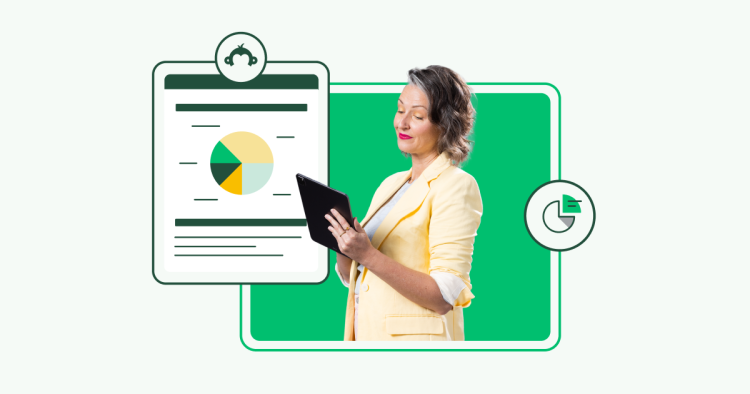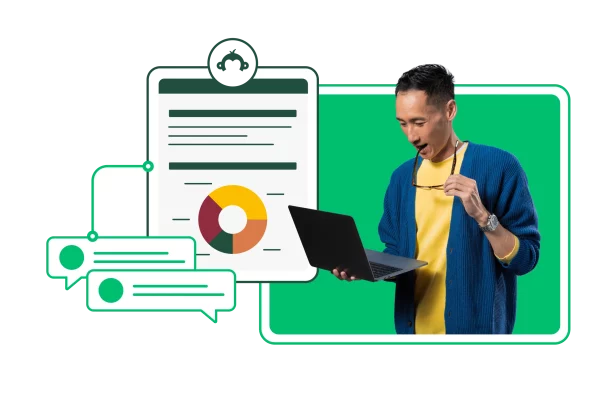無論您想尋找讓公司獲得競爭優勢的深入解析,還是提高客戶忠誠度,客戶意見回饋都是最重要的工具之一。
為什麼呢?客戶意見回饋能協助您瞭解哪些部分處置得宜,哪些部分需要改進,並提供您精益求精所需的資訊。不過,收集客戶意見回饋有多種方法,更具體地來說,您必須從成立焦點小組和使用調查問卷之中二選一。
為了協助您做決定,以下指南會分別說明焦點小組和調查問卷的優缺點,以及透過哪些方法、何時加以運用,從而獲得客戶深入解析。
什麼是焦點小組?
研究人員成立焦點小組時,會精心挑選幾位能夠代表特定目標市場或使用者人物誌的人員。在焦點小組營運期間,研究人員會向小組成員提問以及與他們展開討論。一般而言,焦點小組著重於互動,讓成員處於中立的位置,能夠自在地說出自己真正的想法。
儘管如此,透過焦點小組取得的資料還是相當珍貴,有助於深入瞭解客戶的想法,以及他們為何這麼想。這種研究方法能協助您開發符合市場需求的產品,規劃吸引人的行銷活動,或者因應市場變化。
什麼是調查問卷?
調查問卷是用於向人群樣本收集意見回饋的一種研究方法,通常分類為定量研究,而且與焦點小組不同,會得出結論性結果。
調查問卷在預算和時間方面都有極大的彈性,但也有缺乏彈性的一面:一旦開始進行調查,就不應進行太多變更。因為問題必須維持一致,才能收集到準確的資料。

焦點小組與調查問卷:什麼時機適合用哪一種?
在選擇焦點小組受訪群或調查問卷前,請先寫下您的研究問題,再針對這些問題提出更多問題。換句話說,請思考進行這項研究需要的資訊種類。
- 若要得到滿意的答覆,您只需單向提問,還是最好進行雙方對談?
- 您想測試的概念或使用者體驗是否需要較多說明?
- 您是否想觀察參與者的第一手反應?
- 您是否能坦然接受根據少數人的意見下決策?
- 您是否需要從較大的樣本群取得意見回饋,以獲得顯著的統計結果?
透過焦點小組,您可以更仔細地觀察客戶或目標市場,瞭解哪些事物能鼓舞他們,使他們感到愉快,或者掌握他們遇到的問題或痛點。這些深入解析可提供新產品或服務的資訊,為您帶來競爭洞察力,或加強「客戶的心聲」計畫。
調查問卷通常與特定事件有關聯,您可以透過分析這些資料,協助貴組織進行精準具體的改進。舉例來說,您可以將客戶服務意見回饋調查問卷發送給任何曾與您支援團隊互動過的客戶,如此取得的意見回饋便能協助您追蹤關鍵客戶服務指標,並採取明確的改善措施。

焦點小組和調查問卷的優缺點
仍然無法決定該使用焦點小組還是調查問卷嗎?下方提供一份便利清單,協助您決定該針對客戶或市場調查採用哪一種方法。
焦點小組
優點
- 能聆聽客戶親自分享意見回饋。
- 找出您內部團隊未曾考慮到,但對客戶而言很重要的想法和痛點。
- 在討論期間能夠自由地深入探討問題。
- 能夠透過提出特定後續問題,釐清客戶的意見回饋。
缺點
- 開銷可能包括招募參與者、設施租金、主持人和/或代理人費用、參與報酬、到多個地點去視察的小組的差旅費等。
- 若小組討論由幾位特別勇於發言的參與者所主導,可能會使結果發生偏差。
- 由於有時間限制,因此難以招募到符合資格的參與者。
- 需投入大量時間和精力進行規劃、籌辦、招募,以及差旅 (可能)。
調查問卷
優點
缺點
- 針對客戶和市場研究,若您沒有客戶聯絡資訊,或許很難招募到參與者。
- 無法透過提出後續問題,釐清客戶的意見回饋。
- 參與者可能無法針對調查問卷中沒有列出的問題,主動提供意見回饋。
- 您能提出的問題有限,因為問卷長度很重要。問卷越長,受訪人越不太可能提供縝密完整的回覆。
針對這兩種類型的研究,您需要做的準備相當類似。
如何順利執行焦點小組或調查
1. 設定目標
開始編寫調查問卷或成立焦點小組受訪群之前,請先為您的研究設定目標。目標是指您為了向前邁進或下決策而必須做的事。
寫下您的目標 (別設定太多個!) 後,便能據此調整調查問卷或焦點小組的問題,這樣一來,無論是調查問卷受訪者,還是焦點小組參與者,都將對您不勝感激。
此外,界定目標時,您還可以確認自己的研究是否符合公司的目標或相關關鍵績效指標。與重要內部利益關係人合作也是不錯的辦法,可確保您提出的問題獲得真正有用的資訊。
2. 招募參與者
您希望讓哪些人填寫調查問卷,或參加焦點小組?另一個同樣重要的問題是,您希望排除哪些受訪者?
想讓研究成功,參與者是不可或缺的一環,因此請好好考慮參與者的人口統計資料,包含年齡、性別、家庭收入、職業和居住地點。
您是否有他們的聯絡資訊?您是否需要招募研究受訪群來協助您調查目標市場?您希望受訪者或參與者熟悉您的產品或產品類別嗎?
假如您需要人協助尋找適當的調查問卷填寫對象,SurveyMonkey Audience 可以根據您的要求,替您聯絡到幾乎各種受訪者。
3. 製作焦點小組討論指南
討論指南類似於主持人在焦點小組中使用的腳本,用於組織對話、控制討論節奏、說明討論目標,以及讓所有參與者加入討論。製作討論指南前,請先思考下列問題:
- 您希望主持人提出哪些問題?
- 為了回答參與者的問題,主持人需要瞭解您專案的哪些內容?
- 如果您在測試一項概念或原型,主持人可以給參與者哪些線索或提示?
- 主持人需要瞭解研究目標的哪些事項,才能提出正確的後續問題?
如果您在與研究人員合作,請從焦點小組的目標開始著手;這些目標應與貴組織的目標一致。與研究人員合作確保能以正確的方式提問,避免提出過多主題或任務,讓小組參與者感到無所適從。
4. 撰寫優良的調查問卷問題
製作調查問卷時,請遵照以下最佳實務,以便撰寫出優良調查問卷問題,並避免犯下常見調查問卷錯誤:
- 避免提出誘導式或有既定觀點的問題
- 不要提出複合式問題
- 詢問敏感調查問題時要謹慎
- 使用清楚直白的語言
- 使用正確的問題類型
記得要切中目標,您的目標攸關提出的問題。無論您在製作交易型還是關聯型調查問卷,或者是在封閉式與開放式問題之間求取平衡,都要時時謹記您的目標。
如果您仍然需要人協助您製作可靠的調查問卷和問題,歡迎使用我們專家編寫的調查問卷範本,或者查看我們的 AI 調查問卷產生器,其在接收了您的提示後,可以替您編寫出整份調查問卷。
5. 考慮能為焦點小組參與者做哪些準備
為了展開能獲得豐碩成果的小組對談,請思考自己能為參與者做好哪些準備。準備有助於建立預期,讓參與者能夠自在且自信地參加小組對談。
您能為參與者所做的準備如下:
- 分享焦點小組的舉辦地點、時間和時長
- 告知參與者討論主題
- 說明所有規則或政策,包括任何保密協議
在研究開始前,參與者是否需要預先進行任何活動或做任何作業?您可以考慮在舉辦焦點小組對談前,透過撥打電話或傳送電子郵件,通知參與者須知事項。
6. 為報酬制定預算
衡量獎勵客戶參與的優缺點。若要提供獎勵,您打算為參與者所花費的時間提供多少報酬?針對需要花費一個小時以上的較長調查問卷或焦點小組,可以考慮提供禮物卡。
請記住,您必須謹慎衡量獎勵金額。若金額太高,可能會有不符合資格的人也來參加調查或加入焦點小組;若金額太低,受訪者或許便沒有動力提供詳盡的回覆。
針對焦點小組與調查問卷的結論
依照一般法則,如果您想透過和客戶對話來獲得方向指引,請採用焦點小組,但如果您已經設計了明確周全的問題,且需要一或多群客戶的答案,調查問卷會是較為合適的選擇。
幸運的是,每項專案不一定只能選用一種方法。您透過調查問卷和焦點小組分別取得的深入見解可以相輔相成。調查問卷能提供您下結論時所需的定量資料和統計顯著結果,而焦點小組則可反映您目標市場或客戶的心聲,為您的資料提供「原因」。
充滿自信地研究您的目標市場
準備好要成立焦點小組或進行調查了嗎?SurveyMonkey 能夠在市場研究方面助您一臂之力,例如測試廣告和新概念、監控您的品牌健康狀態,以及獲得具有競爭優勢的深入見解等。深入瞭解如何觸及您的目標市場。
探索更多資源

品牌行銷經理
品牌行銷經理可利用此工具組來瞭解目標受眾、推動品牌成長並增進投資報酬率。

2025 年不能不知道的 AI 行銷統計數據
88% 的行銷人員每天工作都會使用 AI。想知道行銷人員在 2025 年會如何使用 AI 嗎?瞭解如何在這波浪潮中保持優勢。

查看 SurveyMonkey 消費性產品與服務解決方案
消費性產品與服務產業 (包括 CPG、旅遊及餐旅) 都依賴 SurveyMonkey 的深入解析來決定未來的發展。

探索 SurveyMonkey 零售解決方案
瞭解 SurveyMonkey 如何幫助零售公司應對千變萬化的市場趨勢、開發讓客戶滿意的產品,並創造能吸引廣大粉絲的品牌。
